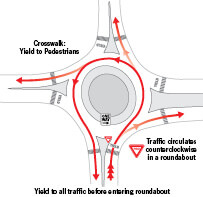13- Roundabouts
Goal: Teach your teen how to enter and drive roundabouts safely.
Location: A road that leads to a one-lane roundabout. Move on to practice at two or more lane roundabouts when your teen is ready.
Roundabouts are circular intersections designed to calm traffic, increase safety, reduce stop-and-go travel, and decrease traffic delays. Roundabouts have proven to be an efficient means to move traffic through congested intersections and have shown to reduce crashes by half (all but eliminating the more severe broadside and head-on collisions). Roundabouts also offer a safe environment for pedestrians, who only have to navigate one-way traffic flow.
Driving in a roundabout can be intimidating, but it’s really quite simple when you know how it works.
Lesson one – five easy steps

This example shows the traffic movement patterns through a one-lane roundabout. The one-lane roundabout is known as one of the safest and most efficient intersections.
- Slow down: Speeds of 15 mph or less are adequate in the roundabout.
- Yield to pedestrians and bicyclists.
- Vehicles entering must always yield to cars already in the roundabout. Look to your left for entering traffic.
- Enter the roundabout when there is a safe gap
in traffic. - Keep your speed low within the roundabout.
- As you approach your exit, turn on your right turn signal.
- Yield to pedestrians and bicyclists as you exit.
Lesson two – emergency vehicles
- If you have not entered the roundabout, pull over and allow emergency vehicles to pass.
- If you have entered the roundabout, continue to your exit, then pull over and allow emergency vehicles to pass.
- Avoid stopping in the roundabout.
Lesson three – two or more lane roundabouts
- As you approach, observe the signs and arrows to determine which lane to use before entering.
- Black and white signs on the side of the road and white arrows on the road will show the correct
lane to use. - If you want to make a left turn, stay in the left lane or other lanes that are signed and marked as
a left turn. - To make a right turn, stay in the right lane or other lanes that are signed and marked as a right turn lane.
- If you want to go straight, observe the signs and arrows to see what lane is correct.